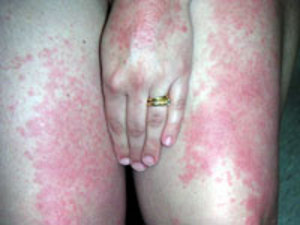PMLE, short for polymorphous light eruption, is a common condition in which exposure to sunlight causes itchy lesions to develop on the skin. The rash is most common on the face, hands, arms, neck or whatever part of the body is exposed to the sun. After the rash has had a chance to completely heal, which may take up to two weeks, it usually doesn’t return after additional sun exposure. However, if the rash is re-exposed to the harmful rays of sunlight, then it will usually cause the breakout to worsen and require a much longer period to heal.
PMLE usually manifests itself in the spring, when temperatures first start heating up and the sun’s UV rays become strong. The rash usually begins after the person is exposed to the sun for ½ hour or so, after about 2 hours. In most patients, the condition goes away after a few weeks of being exposed to the sun on a regular basis. This is known as ‘toughening’ or ‘hardening’ of the skin. Unfortunately, depending on the person, the condition can last the duration of the summer, providing no relief whatsoever.
What causes PMLE?
The exact cause of PMLE is unknown, but it is thought to be the result of an overactive immune system. Certain medications can also cause individuals to react adversely to the sun’s UV rays.
How it the condition treated?
PMLE is most often treated with steroid ointments and creams to relieve the itching and reduce inflammation. For severe and persistent rashes, some dermatologists often prescribe a brief course of oral steroids. This helps to accelerate healing and reduce the severity of the reaction in a quicker amount of time.
How can it be prevented?
If a person knows that every spring that they break out when exposed to the sun, there are several ways to prevent the misery that exposure causes. Staying in the shade is an option for a person that enjoys being outside. Another option is wearing at least SPF 30 sun block, which should prevent rays from penetrating the skin, therefore preventing a rash from occurring.
An additional option that only seems to work for some individuals is light therapy. Light therapy involves having the sensitive individual go to a dermatologist, who will slowly expose the person to increasingly stronger rays of light, starting out very weak. The purpose of light therapy is to gradually ‘toughen’ a person’s skin, reversing its sensitivity to the sun. Unfortunately, this treatment often causes severe breakouts that take weeks to heal and doesn’t often successfully ‘toughen’ the skin. It all depends on the patient and the dermatologist, if light therapy will even be attempted.
PMLE doesn’t have to ruin a person’s life and keep them from participating in the outdoor activities that they like doing. As long as a person stays out of the sun when the UV rays are most dangerous, between 11 a.m. and 3p.m., wears clothing and/or appropriate sun block for protection, then there is no reason why the sensitive person can’t enjoy gardening, sports, amusement parks and other activities that require a person to be outside for long periods of time.
